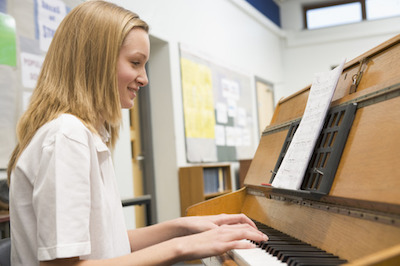One of the most daunting tasks to help your child appreciate music is to buy your child her first piano. If you are not a pianist or musician yourself, where do you start? What should you buy?
There are many choices available in the marketplace today, with an equal number of sources to purchase from. Where do you start? Who do you trust?
After several decades in the business, I have helped many families face this task. And with my experience, I know there are a few things that will make the process even easier. Most people start the process with three questions in mind.
1. My child’s piano teacher recommended getting a piano with full size weighted keys. How do I know if the piano I’m selecting has this in place?
2. Should I buy an acoustic or a digital piano? Is there a difference? How will it impact playability?
3. I’m not sure if my child will continue playing the piano. This may be a six month process like many other things we’ve tried. Should I start with a small keyboard and upgrade when my child shows interest?
Here’s how I answer all three.
1. What is full size weighted keys?
A full size piano has a full set of keys in place. Smaller keyboards come with a more compact size, offering 61 or 72 note keyboards. Beginners start off playing simpler music, and therefore don’t have a full range of playability, so in many cases people settle for smaller keyboards. Yet nothing can be more frustrating than reaching your limit quickly, and not being able to find the proper notes because they simply aren’t there.
If you’ve ever touched the notes on a well built piano, you’ve probably noticed that the keys have a certain touch and feel to them. The keys on a traditional acoustic piano have a weighted action because of the playing process. When a key is pressed, it triggers the hammer into action to hit the string and create sound. Some digital pianos have weighted keys to simulate this hammer action. This is required to help a child build strength in their fingers, and understand how to make music from heavier keys. If they learn on a non-weighted piano, they may have trouble transferring this skill to other pianos, and reduce their chances of playing for the long term.
2. Is there a difference between acoustic and digital?
Some teachers are adamant that their students learn on acoustic. Other teachers concern themselves with how a child once to play. Because digital technology can emulate acoustic piano playing effectively, it’s more important that you choose a quality piano that helps keep the desire high for what your child has in mind. If they want portability and want to play in a band, you may be better investing in a high quality digital piano that allows flexibility.
3. Should I stay with an inexpensive piano until my child has a proven track record and I know she’ll continue playing?
We hear this concern a lot. A piano can be a large expense, depending on the piano you select. And if your child moves on to another interest after only a few months of playing, it can leave you frustrated. Which is why many turn to finding inexpensive models through family, friends, or an Internet search.
There is a difference between pianos. A digital piano without weighted keys has a different feel and sound than a higher end digital piano. An acoustic piano that has sat in a garage for years without tuning and without proper maintenance will never be able to produce the same sound as one well cared for.
The quality of a piano has every impact on a child’s enthusiasm to play. You can’t expect a child to love soccer if they play with a flat ball. You can’t expect a child to love music if you give them an inferior instrument to make music with. The only way to build proper skills and a love for playing is to do so with a quality piano.
If you have any further questions, please stop by our retail location any time.

